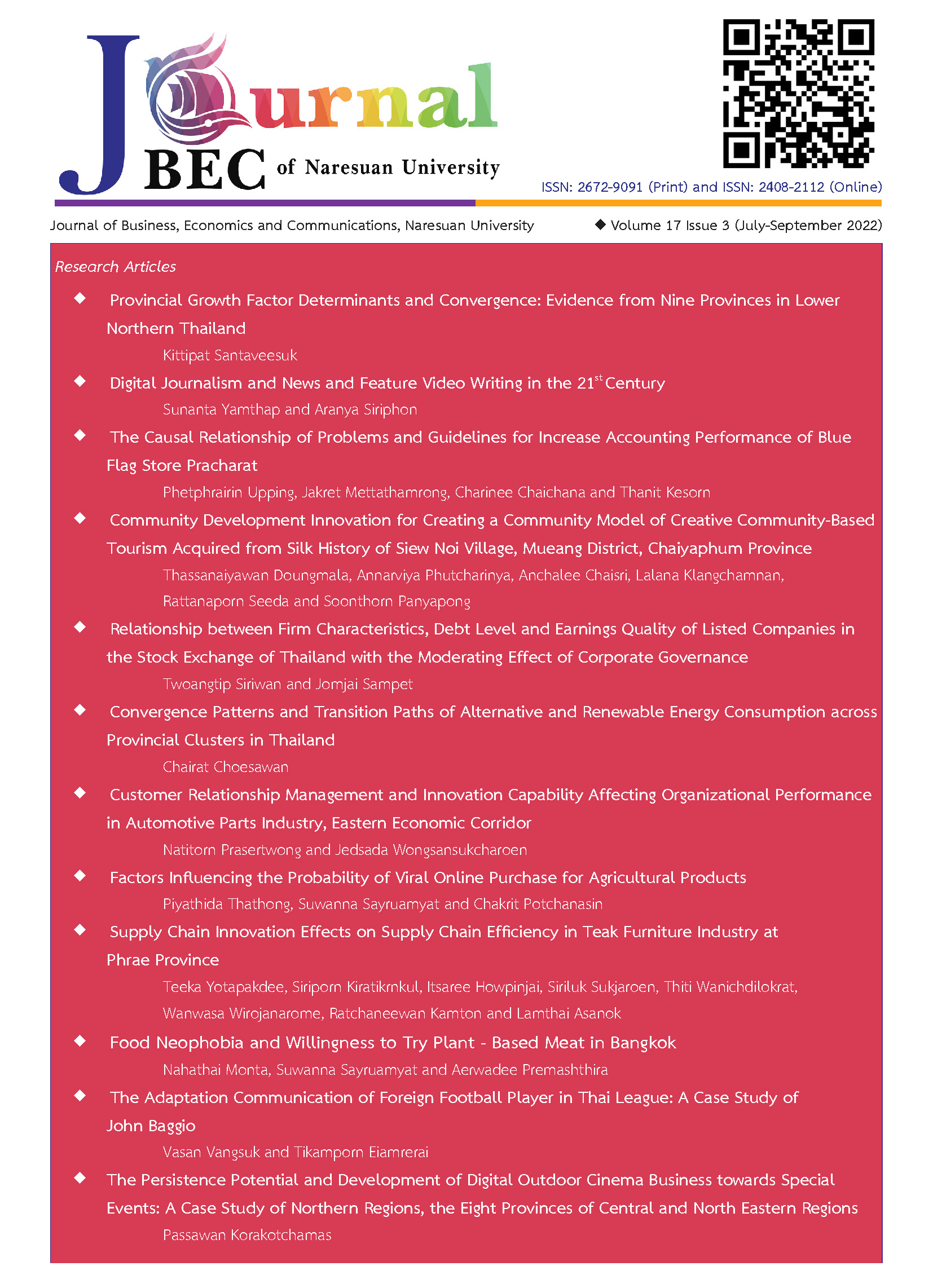Convergence Patterns and Transition Paths of Alternative and Renewable Energy Consumption across Provincial Clusters in Thailand
Main Article Content
บทคัดย่อ
This study examines the stochastic conditional convergence of alternative and renewable energy consumption and determines the structural breaks across 18 provincial clusters in Thailand over the period 2001 – 2018, to find out the convergence patterns and the transition paths of the long-term development. The result reveals that there is no convergence characteristic across the entire sample clusters owing to the existence of two breaks. However, alternative and renewable consumption of 18 provincial clusters can be partially merged into three unique sets of equilibrium with the different transition paths as follows: 1) the group with a high level and showing continued growth (power and cogeneration); 2) the group with a medium level and experiencing a sharp decline (heat), and 3) the group with a low level and maintaining a constant (biofuel). In response to renewable development, Thailand should set out identical alternative targets towards the unique distribution characteristics of renewable instead of a common alternative energy policy like AEDP 2015. To enhance the broader cooperation and reduce the dispersion across provincial clusters in the long run, it is necessary to expand the use of solar power and to convert biomass into the cogeneration of heat and power.
Article Details

อนุญาตภายใต้เงื่อนไข Creative Commons Attribution-NonCommercial-NoDerivatives 4.0 International License.
เอกสารอ้างอิง
AEDD (2015). Renewable energy development status. In DEDE (Eds.), Report of Thailand’s alternative energy development plan: AEDP2015, 2-7. Ministry of Energy, Bangkok, Thailand.
Akarsu, G. and Berke, B. (2016). Convergence of electricity consumption in Turkey: spatial panel data analysis. Panoeconomicus, 67(00), 1-29.
Berk, I., Kasman, A. and Dilara, K. (2018). Towards a common renewable future: the system GMM approach to assess the convergence in renewable energy consumption of EU countries. Energy Economics, 87, 103922.
Bhattacharya, M., Paramati, S.R., Ozturk, I., and Bhattacharya, S. (2016). Effect of renewable energy consumption on economic growth: evidence from top 38 countries. Applied Energy, 733-741.
Camerero, M., Castillo, J., Picazo-Tadeo, A.J. and Tamarit, C. (2013). Eco-efficiency and convergence in OECD countries. Environmental and Resource Economics, 55(1), 1-20.
Choesawan, C. (2019). Renewable energy consumption and human development in Thailand evidence from cointegration and causality. Chiang Mai University Journal of Economics, 23(3), 1-28.
Du, K. (2017). Econometric convergence test and club clustering using stata. STATA Journal, 17, 882-900.
Fotourehchi, Z. (2017). Renewable energy consumption and economic growth: a case study for developing countries. International Journal of Energy Economics and Policy, 7, 61-64.
Hao, Y., Wang, S. and Zhang Z.Y. (2015). Examine the convergence in per capita energy consumption in China with breakpoints. Energy Procedia, 75, 2617-2625.
IRENA (2017). Renewable Energy Outlook: Thailand, International Renewable Energy Agency, Abu Dhabi.
Kasman, A. and Kasman, S. (2020). Convergence of renewable energy consumption in the EU15: evidence from stochastic and club convergence tests. Environmental Science and Pollution Research, 27, 5901-5911.
Maza, A. and Villaverde, J. (2008). The world per capita electricity consumption distribution: signs of convergence? Energy Policy, 36(11), 4255-4261.
Meng, M., Im, K.S., Lee, J. and Tieslau, M.A. (2014). More powerful LM unit root test with non-normal errors. Festschrift in Honor of Peter Schmidt, 343-357.
Meng M., Payne, J.E. and Lee, J. (2013). Convergence in per capita energy use among OECD countries. Energy Economics, 36, 536-545.
Mohammadi, H. and Ram, R. (2012). Cross-country convergence in energy and electricity consumption. Energy Economics, 34(6), 1882-1887.
Lean H., Mishra, V. and Smyth, R. (2016). Conditional convergence in US disaggregated petroleum consumption at the sector level. Journal of Applied Economics, 48(32), 3049-3061.
Lee, J. and Tieslau, M. (2019). Panel LM unit root tests with level and trend shifts. Economic Modelling, 80, 1-10.
Lee, J., Strazicich, M.C. and Meng, M. (2012). Two-step LM unit root tests with trend breaks. International Journal of Statistics and Economics, 1, 81-107.
Lee, J. and Strazicich, M. (2003). Minimum lagrange multiplier unit root test with two structural breaks. The Review of Economics and Statistics, 85(4), 1082-1089.
Payne, J.E., Vizek, M. and Lee, J. (2017). Is there convergence in per capita renewable energy consumption across US states? Evidence from LM and RALS-LM unit root tests with breaks. Renewable & Sustainable Energy Reviews, 70, 715-728.
Pesaran, M.H. (2004). General diagnostic tests for cross section dependence in panels. Cambridge Working Papers in Economics, 435. Faculty of Economics, University of Cambridge.
Phillips, P.C.B., and Sul, D. (2009). Economic transition and growth. Journal of Applied Economics, 24, 1153-1185
Phillips, P.C.B., and Sul, D. (2007). Transition modeling and econometrics convergence tests. Econometrica, 75(6), 1771-1855.
Schnurbus, J., Haupt, H. and Meier, V. (2017). Economic transition and growth: a replication. Journal of Applied Economics, 32, 1039-1042.
Solarin, S.A., Gil-Alana, L.A. and Al-Mulali, U. (2018). Stochastic convergence of renewable energy consumption in OECD countries: a fractional integration approach. Environmental Science and Pollution Research, 25, 17289-17299.


